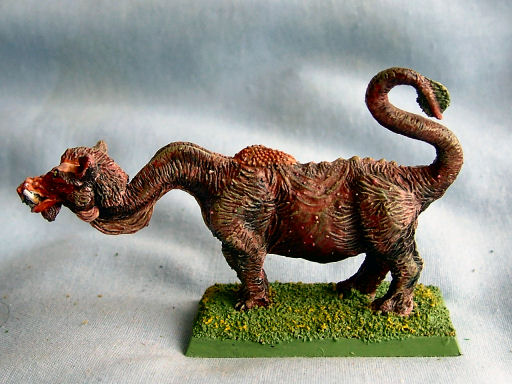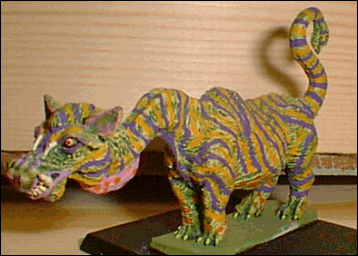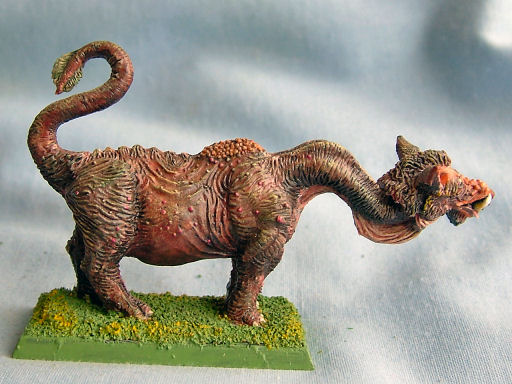

FREQUENCY: Very rare
([Temperate Wilderness Forest])
FREQUENCY: Very
rare ([Tropical Wilderness Forest])
<forest?>
NO. APPEARING: 1-3
ARMOR CLASS: 7
MOVE: 6"
HIT DICE: 6 + 2
% IN LAIR: 60%
TREASURE TYPE: [C]
NO. OF ATTACKS:
1 ~ 13
DAMAGE/ATTACK: 1-6
+ stun
SPECIAL ATTACKS:
Gaze = death, stun
SPECIAL DEFENSES:
Nil
INTELLIGENCE: Semi-
ALIGNMENT: Neutral
SIZE: L (6' at shoulder)
LEVEL/X.P. VALUE: VI | 700
+ 8
SAVES: 10.11.12.12.13
This nightmare creature
is loathsome beyond description and has no redeeming features.
Its body resembles
that of a huge, bloated buffalo and gives off an offensive odor.
The catoblepas'
neck is long and thin, and perched atop it is a big head uglier than that
of a warthog.
Its legs are thick
and stumpy, much like a hippopotamus.
The creature's tail
is strong and snakey, however, and moves with amazing swiftness to strike
enemies.
Any creature so
struck has a base 75% chance of being stunned for 1-10 melee rounds;
the base chance
being modified by adiustment downward by 5% for every level (or hit die
for monsters) above 1.
-
Thus, if an 11th level character is struck by the tail there is only a
25% chance of stunning.
Perhaps its habitat
-- fetid swamps and miasmal marshes --
caused the bizarre
combination of genetic characteristics in this monster,
or perhaps it was
due to some ghastly tinkering with life by a demented godling.
In any case, the
most horrid aspect of the catoblepas is its bloodshot eyes.

Gaze: The
gaze of the catoblepas is equal to a death ray, extending 6" from the
eyes (even into
the astral and ethereal planes). Any creature which meets
this gaze dies without
any chance to save itself. Complete surprise (a 2 on
6-sided die) means
one of the party encountering the monster has met its
gaze. Otherwise
the very weak neck of the catoblepas has only a 25%
chance of raising
the head high enough to use its eyes. If both parties are
still this chance
increases by 15% per melee round. If the monster must
follow quick movements,
or if it is shambling along in pursuit of prey,
there is only a
10% chance per melee round of the neck raising the head
sufficiently high
to fix its gaze. A fleeing victim, even with eyes averted, is
subject to the deadly
effect of the catoblepas' eyes, although there is a
SAVE.


Cab wrote:
Gary, although I'm sure
someone must have asked you this, I'll ask it anyway because I can't see
an answer around here and I'm kind of curious.
Gorgons in all versions of
D&D
seem to bear little relationship with the classical Greek idea of what
a gorgon was.
How did the D&D gorgon
as a petrifying bovine come about?
Cheers.

The bull-like gorgon
with iron scales is found in medieval bestiaries.
i know it for a fact because
that's where I got the critter--along with the catoblepas and a handful
of other monsters;)
Cheers,
Gary